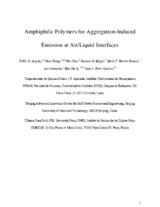Amphiphilic Polymers for Aggregation-Induced Emission at Air/Liquid Interfaces
Autor
Argudo, Pablo G.
Zhang, Nian
Chen, Hui
Miguel, Gustavo de
Martín-Romero, M.T.
Camacho, Luis
Li, Min-Hui
Giner-Casares, Juan J.
Editor
ElsevierFecha
2021Materia
NanostructuresNanotechnology
Polymersomes
Aggregation-Induced Emission
Hydrophilic polyethylene glycol
Hydrophobic AIE polymer poly(tetraphenylethylene-trimethylenecarbonate)
Amphiphilic polymers
Self-assembly
METS:
Mostrar el registro METSPREMIS:
Mostrar el registro PREMISMetadatos
Mostrar el registro completo del ítemResumen
Polymersomes and related self-assembled nanostructures displaying Aggregation-Induced Emission (AIE) are highly relevant for plenty of applications in imaging, biology and functional devices. Experimentally simple, scalable and universal strategies for on-demand self-assembly of polymers rendering well-defined nanostructures are highly desirable. A purposefully designed combination of amphiphilic block copolymers including tunable lengths of hydrophilic polyethylene glycol (PEGm) and hydrophobic AIE polymer poly(tetraphenylethylene-trimethylenecarbonate) (P(TPE-TMC)n) has been studied at the air/liquid interface. The unique 2D assembly properties have been analyzed by thermodynamic measurements, UV-vis reflection spectroscopy and photoluminescence in combination with molecular dynamics simulations. The (PEG)m-b-P(TPE-TMC)n monolayers formed tunable 2D nanostructures self-assembled on demand by adjusting the available surface area. Tuning of the PEG length allows to modification of the area per polymer molecule at the air/liquid interface. Molecular detail on the arrangement of the polymer molecules and relevant molecular interactions has been convincingly described. AIE fluorescence at the air/liquid interface has been successfully achieved by the (PEG)m-b-P(TPE-TMC)n nanostructures. An experimentally simple 2D to 3D transition allowed to obtain 3D polymersomes in solution. This work suggests that engineered amphiphilic polymers for AIE may be suitable for selective 2D and 3D self-assembly for imaging and technological applications.

